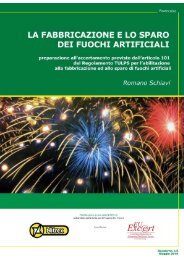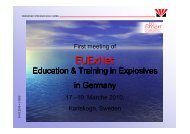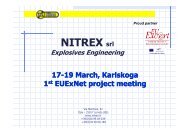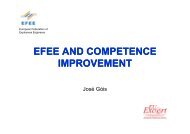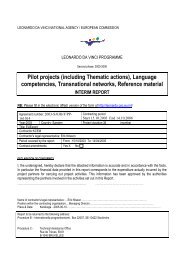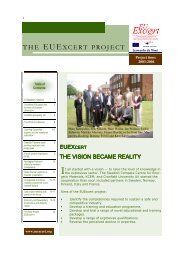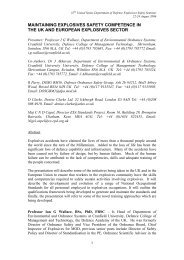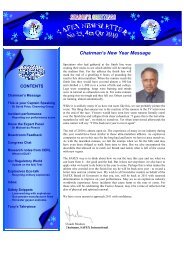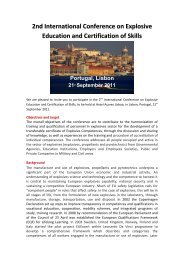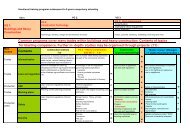Contents of Annexes Annex 1 List of Partners in EUEXcert Annex 2 ...
Contents of Annexes Annex 1 List of Partners in EUEXcert Annex 2 ...
Contents of Annexes Annex 1 List of Partners in EUEXcert Annex 2 ...
Create successful ePaper yourself
Turn your PDF publications into a flip-book with our unique Google optimized e-Paper software.
Key Description<br />
Roles<br />
1 Research and develop explosive substances and articles<br />
2 Develop and manage explosives safety<br />
3 Test and evaluate explosive substances and articles <strong>in</strong> field trials<br />
4 Manufacture explosive substances and articles<br />
5 Ma<strong>in</strong>ta<strong>in</strong> and repair explosive substances and articles<br />
6 Procure explosive substances and articles<br />
7 Store and move explosive substances and articles<br />
8 Transport explosive substances and articles<br />
9 Manage explosives facilities<br />
10 Prepare and use explosive substances and articles for eng<strong>in</strong>eer<strong>in</strong>g and<br />
enterta<strong>in</strong>ment purposes<br />
11 Dispose <strong>of</strong> explosive substances and articles<br />
12 Enable the pubic and armed services to cont<strong>in</strong>ue their regular activities<br />
<strong>in</strong> peace and war by controll<strong>in</strong>g and remov<strong>in</strong>g munition threats<br />
13 Support the explosive substances and articles function<br />
Table 3 The ma<strong>in</strong> functions <strong>of</strong> explosives substances and articles occupations<br />
Hav<strong>in</strong>g established the key roles further workshops were conducted with<br />
employers engaged <strong>in</strong> undertak<strong>in</strong>g these roles. These occupational work<strong>in</strong>g<br />
groups conducted functional analysis workshops, which were lively and<br />
sometimes contentious, attempted to derive all <strong>of</strong> the activities necessary to<br />
conduct a key role. Different organisations used different vocabulary to<br />
describe an activity and <strong>of</strong>ten expected different th<strong>in</strong>gs from their workers.<br />
Consensus was f<strong>in</strong>ally achieved <strong>in</strong> all but a few areas. The analysis breaks<br />
down each key role <strong>in</strong>to a series <strong>of</strong> activities some <strong>of</strong> which can be further subdivided.<br />
The first example <strong>in</strong> figure 1 shows the results <strong>of</strong> part <strong>of</strong> the functional<br />
analysis for a worker undertak<strong>in</strong>g research <strong>in</strong>to explosives.<br />
In total some 60 pr<strong>in</strong>cipal activities were identified for this key role many <strong>of</strong><br />
which can be further subdivided to give a total <strong>of</strong> 124 activities which might be<br />
performed to undertake research and development work on explosives<br />
substances and articles. Many <strong>of</strong> these activities are specific to explosives<br />
research whilst others are generic <strong>in</strong> nature and would typically be undertaken<br />
to support any research activities. Thus activities 1.26 to 1.60 are occupational<br />
standards drawn from other occupational standards appropriate for laboratory<br />
workers.<br />
62



